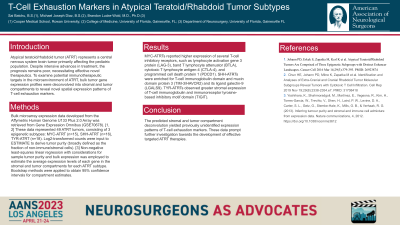T-Cell Exhaustion Markers in Atypical Teratoid/Rhabdoid Tumor Subtypes
T-cell Exhaustion Markers in Atypical Teratoid/rhabdoid Tumor Subtypes
Friday, April 21, 2023


Sai Batchu, BS (they/them/theirs)
Medical Student
Cooper Medical School
Montville, New Jersey, United States
ePoster Presenter(s)
Introduction: Atypical teratoid/rhabdoid tumor (ATRT) represents a central nervous system brain tumor primarily affecting the pediatric population. Despite intensive advances in treatment, the prognosis remains poor, necessitating effective novel therapeutics. To examine potential immunotherapeutic targets in the microenvironment of ATRT, bulk tumor gene expression profiles were deconvolved into stromal and tumor compartments to reveal novel spatial expression patterns of T-cell exhaustion markers.
Methods: Bulk microarray expression data developed from the Affymetrix Human Genome U133 Plus 2.0 Array was retrieved from Gene Expression Omnibus (GSE70678). These data represented 49 ATRT tumors, consisting of 3 epigenetic subtypes: MYC-ATRT (n=15), SHH-ATRT (n=16), TYR-ATRT (n=18). Log2-transformed counts were input to ESTIMATE to derive tumor purity (broadly defined as the fraction of non-immune/stromal cells). Non-negative least-squares linear regression with considerations for sample tumor purity and bulk expression was employed to estimate the average expression levels of each gene in the stromal and tumor compartments for each ATRT subtype. Bootstrap methods were applied to obtain 95% confidence intervals for compartment estimates.
Results: MYC-ATRTs reported higher expression of several T-cell inhibitory receptors, such as lymphocyte activation gene 3 protein (LAG-3), band T lymphocyte attenuator (BTLA), cytotoxic T lymphocyte antigen-4 (CTLA-4), and programmed cell death protein 1 (PDCD1). SHH-ATRTs were enriched for T-cell immunoglobulin domain and mucin domain protein 3 (TIM-3/HAVCR2) and its ligand galectin-9 (LGALS9). TYR-ATRTs observed greater stromal expression of T-cell immunoglobulin and immunoreceptor tyrosine-based inhibitory motif domain (TIGIT).
Conclusion : The predicted stromal and tumor compartment deconvolution yielded previously unidentified expression patterns of T-cell exhaustion markers. These data prompt further investigation towards the development of effective targeted ATRT therapies.
Methods: Bulk microarray expression data developed from the Affymetrix Human Genome U133 Plus 2.0 Array was retrieved from Gene Expression Omnibus (GSE70678). These data represented 49 ATRT tumors, consisting of 3 epigenetic subtypes: MYC-ATRT (n=15), SHH-ATRT (n=16), TYR-ATRT (n=18). Log2-transformed counts were input to ESTIMATE to derive tumor purity (broadly defined as the fraction of non-immune/stromal cells). Non-negative least-squares linear regression with considerations for sample tumor purity and bulk expression was employed to estimate the average expression levels of each gene in the stromal and tumor compartments for each ATRT subtype. Bootstrap methods were applied to obtain 95% confidence intervals for compartment estimates.
Results: MYC-ATRTs reported higher expression of several T-cell inhibitory receptors, such as lymphocyte activation gene 3 protein (LAG-3), band T lymphocyte attenuator (BTLA), cytotoxic T lymphocyte antigen-4 (CTLA-4), and programmed cell death protein 1 (PDCD1). SHH-ATRTs were enriched for T-cell immunoglobulin domain and mucin domain protein 3 (TIM-3/HAVCR2) and its ligand galectin-9 (LGALS9). TYR-ATRTs observed greater stromal expression of T-cell immunoglobulin and immunoreceptor tyrosine-based inhibitory motif domain (TIGIT).
Conclusion : The predicted stromal and tumor compartment deconvolution yielded previously unidentified expression patterns of T-cell exhaustion markers. These data prompt further investigation towards the development of effective targeted ATRT therapies.
